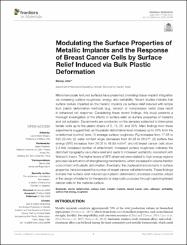| dc.contributor.author | Uzer, Benay | |
| dc.date.accessioned | 2021-01-18T07:50:25Z | |
| dc.date.available | 2021-01-18T07:50:25Z | |
| dc.date.issued | 2020 | en_US |
| dc.identifier.issn | 2296-8016 | |
| dc.identifier.uri | https://hdl.handle.net/20.500.12573/443 | |
| dc.description.abstract | Micro/nanoscale textured surfaces have presented promising tissue-implant integration via increasing surface roughness, energy, and wettability. Recent studies indicate that surface texture imparted on the metallic implants via surface relief induced with simple bulk plastic deformation methods (e.g., tension or compression tests) does result in enhanced cell response. Considering these recent findings, this study presents a thorough investigation of the effects of surface relief on surface properties of implants and cell adhesion. Experiments are conducted on the samples subjected to interrupted tensile tests up to the plastic strains of 5, 15, 25, and 35%. Main findings from these experiments suggest that, as the plastic deformation level increases up to 35% from the undeformed (control) level, (1) average surface roughness (R-a) increases from 17.58 to 595.29 nm; (2) water contact angle decreases from 84.28 to 58.07 degrees; (3) surface free energy (SFE) increases from 36.06 to 48.89 mJ/m(2); and (4) breast cancer cells show 2.4-fold increased number of attachment. Increased surface roughness indicates the distorted topography via surface relief and leads to increased wettability, consistent with Wenzel's theory. The higher levels of SFE observed were related to high-energy regions provided via activation of strengthening mechanisms, which increased in volume fraction concomitant with plastic deformation. Eventually, the displayed improvements in surface properties have increased the number of breast cancer cell attachments. These findings indicate that surface relief induced upon plastic deformation processes could be utilized in the design of implants for therapeutic or diagnostic purposes through capturing breast cancer cells on the material surface. | en_US |
| dc.language.iso | eng | en_US |
| dc.publisher | FRONTIERS MEDIA SA, AVENUE DU TRIBUNAL FEDERAL 34, LAUSANNE, CH-1015, SWITZERLAND | en_US |
| dc.relation.isversionof | 10.3389/fmats.2020.00099 | en_US |
| dc.rights | info:eu-repo/semantics/openAccess | en_US |
| dc.subject | plastic deformation | en_US |
| dc.subject | surface relief | en_US |
| dc.subject | metallic implants | en_US |
| dc.subject | breast cancer cells | en_US |
| dc.subject | adhesion | en_US |
| dc.subject | wettability | en_US |
| dc.subject | surface free energy | en_US |
| dc.subject | roughness | en_US |
| dc.title | Modulating the Surface Properties of Metallic Implants and the Response of Breast Cancer Cells by Surface Relief Induced via Bulk Plastic Deformation | en_US |
| dc.type | article | en_US |
| dc.contributor.department | AGÜ, Mühendislik Fakültesi, Makine Mühendisliği Bölümü | en_US |
| dc.contributor.authorID | 0000-0001-8778-1660 | en_US |
| dc.identifier.volume | Volume: 7 | en_US |
| dc.relation.journal | FRONTIERS IN MATERIALS | en_US |
| dc.relation.publicationcategory | Makale - Uluslararası - Editör Denetimli Dergi | en_US |


















